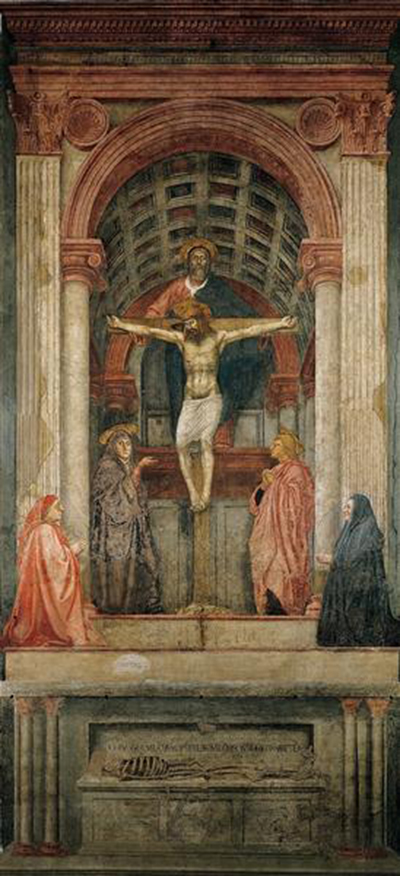15th century artist, Masaccio, creates a captivating fresco titled The Holy Trinity, leaving his mark on art as the timeless painting gains popularity.
The art piece was created as an altarpiece for a small chapel in Italy, as many of the art works that Masaccio was commissioned to create. The figures are painted roughly life size, showcasing members of the holy family and church.
The artwork is one of Masaccio's first to carry a vanishing point. This technique is also evident in his other painting, The Tribute Money. The use of a vanishing point was not commonly used at the time as it was an innovative technique used later on by prominent artists. The vanishing point within the fresco is located on a viewerÕs eye level, allowing for the artwork to seem even more in depth.
The art work is recorded to have had a significant impact on future artists for-passing Masaccio as they used the technique of a vanishing point. Through this aspect, figures within the artwork were able to look three-dimensional with more depth added. As the art work was created as an altarpiece for a church, its three-dimensional occupation allows for the figures to seem lifelike meeting with the viewer's gaze.
There has been an array of interpretations behind the artwork as critics debate the symbolism behind the work. Many see the painting as a traditional biblical illustration of Jesus dying on the cross for humanity's sins, however many see MasaccioÕs imagery to perhaps mean something else.
The two bottom figures at the right and left of the painting seem to resemble patrons kneeling and idolizing Jesus. The interesting note to view are the swift smiles painted across both character's faces. Their smiles add a different emotion to the artwork in comparison to the distraught expressions of the Saints beneath their leader.
Another interesting element to note is that Masaccio had showcased both the Holy Father, and his only begotten son dead. The artist had only solely depicted the virgin mother and her son, but never the father and son. As the artwork was created two years prior to the death of Masaccio, it seems as if the painting was a transitional piece for the artist.
Masaccio had gone into greater detail to depict structures and figures than many of his previous art work did.
Alongside, the artist had decided to step away from his usual technique of illustrating his frescos in bright colours towards more monotones shades. The artwork continues to carry the exquisite detail and form evident throughout Masaccio's artwork.
Masaccio also pays tribute to Italian architecture as he illustrates an array of structures in Gothic styles and traditional materials. As the painting is a reflection of the church it was located in, the viewer is able to witness the beautiful architecture used to create these holy spaces.
Long columns fill the side of the painting, while the accentuating points are covered in exquisite detail and hand carved mastery. Classic shades of white and bronze fill the walls, illustrating the elegant style at the time. These soft illustrations by Masaccio allow historians to have a stronger understanding of the different structures and styles used during the Renaissance Era, in relation to both art and architecture.




